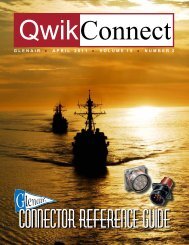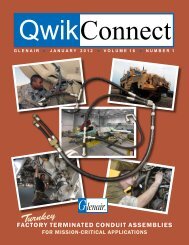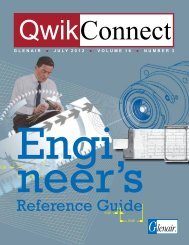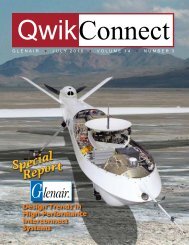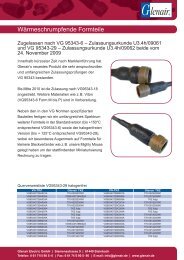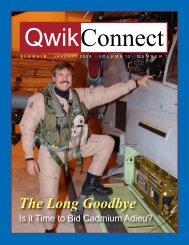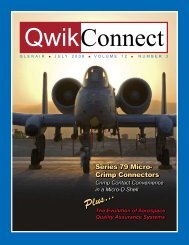April 2010 - Glenair, Inc.
April 2010 - Glenair, Inc.
April 2010 - Glenair, Inc.
Create successful ePaper yourself
Turn your PDF publications into a flip-book with our unique Google optimized e-Paper software.
Applications<br />
Though composite technology is being applied<br />
to the weather decks in numerous applications, there<br />
is still a requirement for fire hardening especially in<br />
and around flight OPS and ventilation areas. Special<br />
consideration has to be given toward V-22 Osprey<br />
and the F-35 Joint Strike Fighter.<br />
It is very important for due diligence with<br />
employing these materials as a simple material<br />
substitution. As these materials are orthotropic<br />
in nature, their material properties dominate in<br />
specific layers opposed to homogeneous properties<br />
of isotropic materials, such as metals. The user<br />
is cautioned with the reminders that, as with all<br />
materials and processes, composite materials are<br />
not the panacea! The designer / engineer needs<br />
to be very sensitive to the end application, and<br />
not installing them in the same manner as metallic<br />
components.<br />
Waterborne■Applications<br />
The Navy’s aircraft carriers must operate at high<br />
speeds to provide adequate wind velocity for the<br />
launch of high performance jet aircraft. Navy surface<br />
combatants must not only keep up with the aircraft<br />
carrier to afford battle force protection, but also to<br />
deploy rapidly to world hot spots. The propulsion train<br />
and shaft line components have been engineered to<br />
provide the necessary thrust.<br />
To reduce drag and to protect these<br />
components, propulsion running gear fairings are<br />
used to smooth transition joints in the assembly.<br />
These fairing components have traditionally<br />
been welded in place in the dry dock during ship<br />
construction or maintenance cycles. These fairings<br />
are technically not removable following launching.<br />
Heat affected zones, from the installation welding<br />
process, result in anodic areas that lead to eventual<br />
failure of the fairing to remain in place.<br />
The repair of the failed fairings is a major<br />
maintenance issue that must be done in drydock<br />
due to the weight and the complexity of the removal<br />
process. Specifically the legacy metallic rope guards<br />
were made from carbon steel to enable waterborne<br />
QwikConnect<br />
repair procedures in the event of fouling, and<br />
replacement of sacrificial anodes and the occasional<br />
stave bearing replacement. For the copper-nickel<br />
metal fairwaters, the waterborne maintenance issues<br />
are exacerbated as there is no Navy approved<br />
underwater welding procedure for nickel based alloys.<br />
Composite Fairwaters and Rope guards are<br />
an ideal alternative for these components, as they<br />
provide low cost, low maintenance service over<br />
an extended interval. Since they are relatively light<br />
weight and attached with removable fasteners,<br />
8 QwikConnect n <strong>April</strong> <strong>2010</strong>



